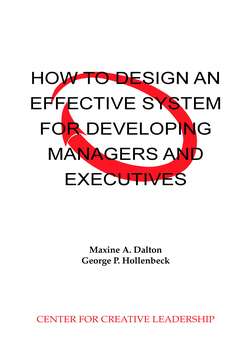Читать книгу How to Design an Effective System for Developing Managers and Executives - Maxine Dalton - Страница 9
На сайте Литреса книга снята с продажи.
ОглавлениеIntroduction
At CCL we believe that development of managers and executives depends on a combination of ability, willingness to learn, and opportunity. Frequently, not much can be done about the first two—ability or willingness to learn; so helping the person develop must focus on opportunity—providing the opportunities to learn in a way that maximizes the odds that learning, growth, and development will take place.
This report offers a model for a process of development planning that provides such opportunities. It is based on the “Tools for Developing Successful Executives” program, and is meant to capture its lessons and put them in usable form.
The model has six steps (each covered in its own section):
1. Find and use organizational support for creating a process, not an event.
2. Define the purpose of the program and behaviors to be developed.
3. Provide feedback for target participants, giving them baseline information about their current skill level and showing them how they can improve or learn new skills.
4. Define and communicate the role of the manager in development and orient the manager to the program.
5. Help participants write and use a development plan.
6. Make the program accountable by defining the outcome measures that capture the program purpose and evaluate the program against those measures.
If you are new to the field of human resources development or at the beginning of your own design effort, we intend that the model be used sequentially and cumulatively. Each step leads to the next. The program designer has to consider the impact of each step on what has gone before and what will follow. For example, you will see that buy-in and support (Step 1) is built on accountability (Step 6). Accountability is built on clarity of program purpose (Step 2), and so forth.
If you are an experienced HR development practitioner or if you are trying to evaluate and improve an existing program, we offer the model as a checklist, a way to review each of your components to determine if the sense of purpose, implementation, and accountability flow in a logical way from the business need that is driving the program toward the outcomes that the business wants.
We suggest that you think of the six steps as you would instructions for building a model airplane. Lay out all of the pieces first. Make sure all of the parts are there. Read through the instructions before you start. Think about how the parts fit together.
Writing about development planning presents language problems. What do we call the target of our development efforts—the person whom we hope will develop? And what do we call that person, key in the development process, who used to be called your manager, or boss, or supervisor, but who may in the modern organization do very little traditional managing?
We have adopted a convention that we think will be clear. The person whose development we are planning we will call the participant—whether an engineer or salesperson, a manager with a formal hierarchy, or a team leader with limited traditional supervisory responsibility; or whether an executive somewhere on the rungs of the executive ladder—but not so high as to be the “boss of all bosses.” The individual with administrative responsibility for the development of this participant we will call the manager, again recognizing that our usage may not reflect the complexities of the authority relationship in the modern organization, and that in using manager we may be referring to a person with no formal subordinates or with thousands.
We also want to alert you to our use of the word program. As will be clear in this report, we want to present development as a process and not as an event. Programs of development occur as a result of many interlocking steps and events over time, each building on what has gone before. Developmental programs may be punctuated by events, such as receiving feedback in a formal 360-degree-feedback activity, but that event is not the program. We will use the term program to refer to the entire process of development, and terms like step, event, or activity to refer to program components.
There is yet another caveat about the use of language. Throughout this report we refer to the human resources professional as the person who designs and conducts the development program. We know that there is a subgroup of professionals within the HR function called the human resources development (HRD) professional. However, not all HR professionals who practice development may hold that title if they are in smaller companies or perform a variety of HR functions. Therefore, we refer to the person who does the design and development as the HR professional.
Whatever words we use, we ask your translation to any form that will help you further the process of development planning in your organization.
